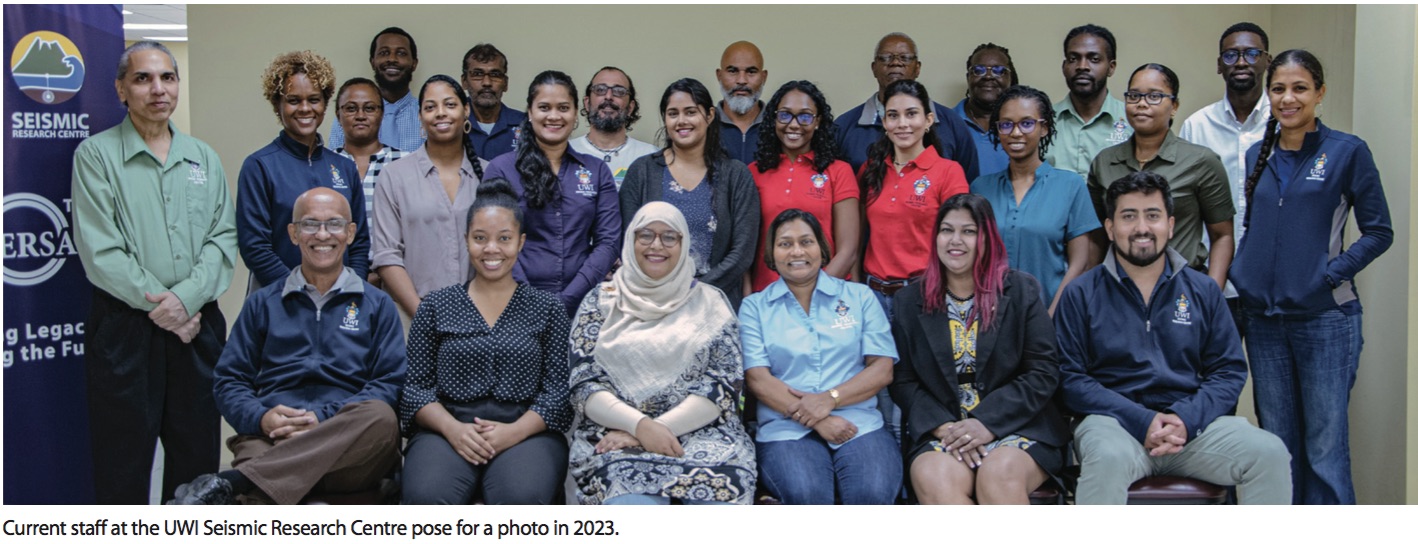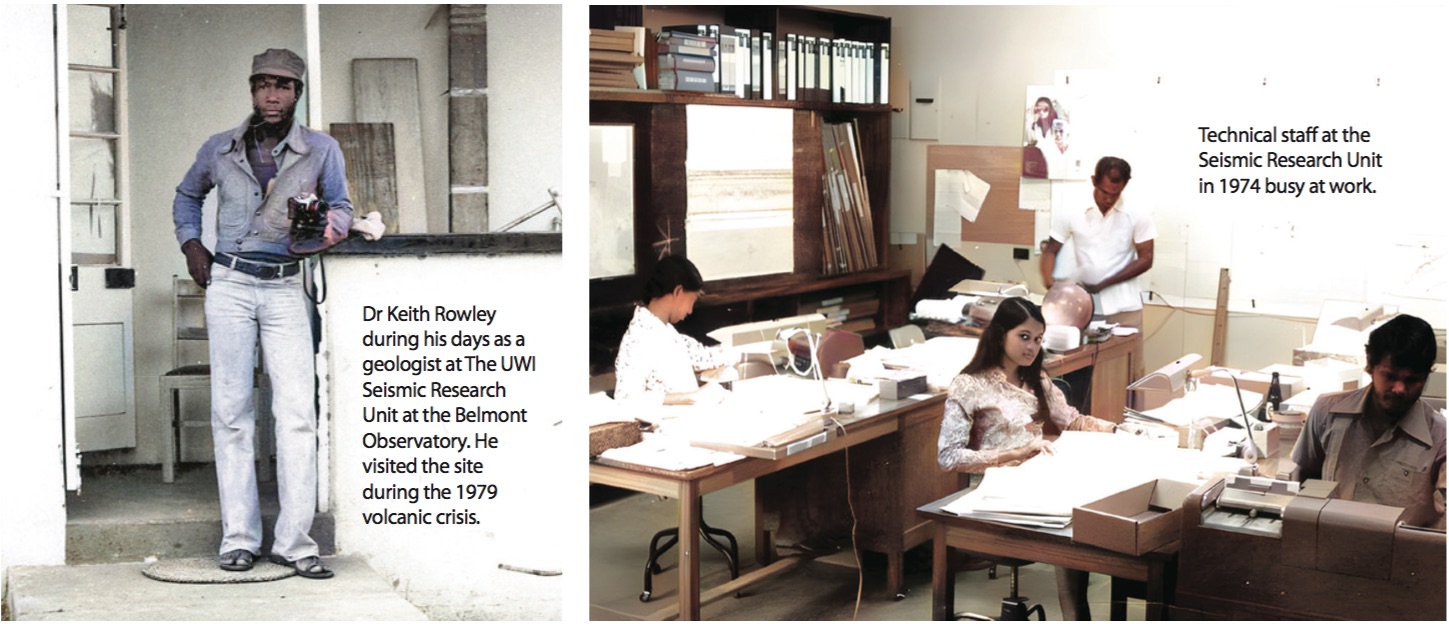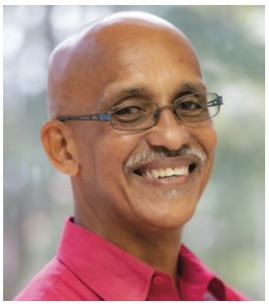
Since its founding as the Volcanological Research Department in 1953 – and subsequent restructurings to Seismic Research Unit in the 1960s and The UWI Seismic Research Centre (SRC) in 2008 – SRC has been on a mission to provide services which protect Caribbean lives and livelihoods from the hazards associated with earthquakes, volcanoes, and tsunamis.
As such, its long history of monitoring and studying the Caribbean’s geological activities have become intertwined with significant events like the 1995 eruption of Montserrat’s Soufrière Hills volcano, eruptions of Grenada’s Kick ‘em Jenny submarine volcano, and eruptions of St Vincent’s La Soufrière, including the most recent one in 2020/2021.
As the SRC commemorates its 70th anniversary this year, UWI TODAY spoke with current Director Dr Erouscilla Joseph, and former Directors Professor Richard Robertson (2004-2008/2013-2019), Dr Joan Latchman (2011-2013), and Lloyd Lynch (1991-1994).

While some people are familiar with the SRC’s earthquake monitoring services, Dr Joseph wants the public to know it does much more.
A trained volcanologist, she started her journey at the centre in 2002 as part of a team selected to establish a new geothermal monitoring programme in Dominica and St Lucia.
She told UWI TODAY, “What some people may not know is that the centre was first established as a volcanology unit to respond to volcanic activity and then expanded to include seismological services.
“We do everything including volcano seismology, earthquake seismology, geology, petrology, geophysics, technical services associated with geothermal energy, ground deformation monitoring, and education and outreach services.”
In 2008, Dr Joseph was also part of a team deployed to Montserrat to manage the Montserrat Volcano Observatory and respond to an ongoing eruption of the Soufrière Hills volcano.
She also helped manage the SRC’s co-ordinated response to the 2020/2021 eruptions of La Soufrière in St Vincent.
Recently, the centre has also made inroads in building its capacity to use InSAR (Interferometric Synthetic Aperture Radar) satellite imagery to detect surface deformations associated with geological processes.
Dr Joseph explained that while the SRC continues to make progress in developing its research and monitoring capabilities, there’s been a parallel drive to increase outreach activities as it is important for all stakeholders – including the public – to have a better understanding of the Caribbean’s geological processes that can affect them.

She added, “We continue to expand our expertise, and I see the centre being able to provide increased amounts of technical services to a wider range of stakeholders, so that the full potential of the centre can be greater actualised.”
Moving forward, she wants regional governments to continue providing the SRC with adequate funding to ensure the provision of essential monitoring services required to provide warning and advice needed for informed decision-making.

A former head when the SRC was still a unit, and current research fellow in instrumentation, Mr Lynch is responsible for the design and upkeep of the centre’s geophysical instruments which monitor earthquake and volcanic activity throughout the region.
He told UWI TODAY that, over the years, advancements in technology have seen changes to the instruments that the SRC uses.
With each technological upgrade, Mr Lynch said the centre has been able to scale up the number of the stations it operates and record events with higher fidelity.
“During my time at the centre – which spans nearly 40 years – we have been through three generations of monitoring equipment and communications technologies used to move data from remote monitoring instruments to the processing centre.”
Today, the SRC depends on the internet and satellite communications systems to link its growing network of modern, low-power computer-based remote monitors/recorders. Such systems significantly bolster the region's early warning services for volcanic activity and tsunamis.
The quality and quantity of data acquired serve to inform, test, and validate models that provide insights of the tectonic processes that fuel the underlying hazards.

Serving as the SRC’s director from 2011-2013, Dr Latchman started her journey as a seismic technician in 1972 upon completing her A-Level studies. She was one of just three female workers.
Dr Latchman told UWI TODAY, “In those years (when I first started), the gender balance in seismic was male dominated, and I was the only female technician.
“We had two other ladies apart from myself, who were the secretary and the typist. The academic staff was also primarily male and foreign.”
As a technician, Dr Latchman worked with former unit head – and now Prime Minister – Dr Keith Rowley, who was a geologist at the unit.
Dr Rowley, she said, encouraged her to pursue higher studies to move up the academic ranks.


Dr Latchman recalled, “In 1977, Dr Rowley asked me one day, ‘so what do you plan to do? Do you plan to sit here and read records for the rest of your life?’
“I told him that I wanted to do more studies, and I was working towards it.
“At that time, he asked if I would work and study, then suggested to the unit’s head that I be allowed to work and study.”
While there were hurdles, Dr Latchman was able to successfully complete a major in mathematics, and minor in computer science, in 1980.
With that additional qualification, she was able to secure a fellowship at the International Seismological Centre from 1988-1990.
She would eventually go on to successfully complete her masters in 1998 and PhD in 2009.
Appointed the SRC’s director in 2011, Dr Latchman is happy to have seen an improvement in the gender balance over time and more women participating in the field of seismic research.
“I hope that the centre continues to serve the region and be an agency to which stakeholders can look for advice on geological hazards, and necessary action is taken to mitigate the effects of those hazards,” she commented.

Looking forward, Professor Robertson wants the SRC to continue expanding its public outreach and create even more projects in collaboration with communities.
In doing so, he said the centre will continue to learn from the communities they serve, teach people in the process, and expand its data collection capacity when they empower residents to assist in monitoring activities.
He explained, “We are still an institute that focuses on alerting and advising the government authorities about what is happening with geological systems across the region.

“But I think we have evolved towards doing a lot more than that, which includes information and outreach in the public domain, as well as a variety of products like data which various stakeholders can use.”
Outside of its core functions, Prof Robertson said the SRC has also been on a drive to develop the capacity of Caribbean professionals in the field of seismology and volcanology.
For example, he said the centre’s personnel in earlier years were mainly composed of foreign professionals, but this has changed over the years due to wide-ranging efforts.
“While that was the case in the past, we have moved towards growing that pool of people both in terms of now having master’s and PhD programmes in volcanology and seismology.
“Within our own staff, we have also focussed on developing the capacity of people to take up more leadership roles.
“A lot of the senior staff we have now are from within the region, so we took a strategic decision a couple years ago to grow the centre in this way.”
For more information on The UWI Seismic Research Centre and their work, visit them at https://uwiseismic.com/.